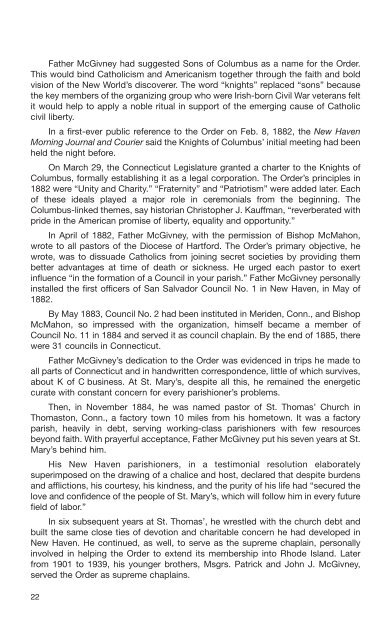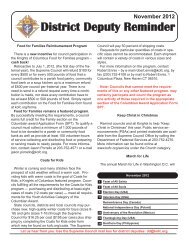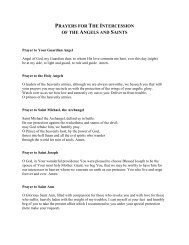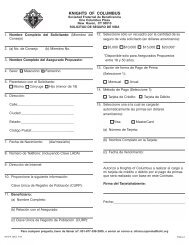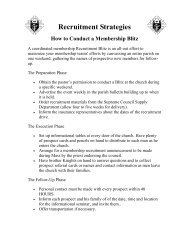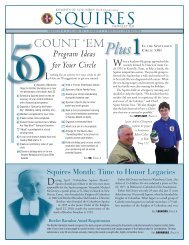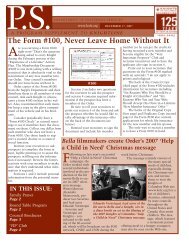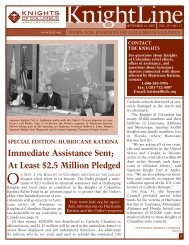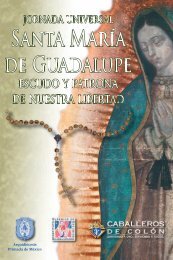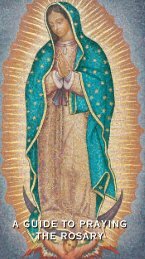Chaplain's Handbook (#945) - Knights of Columbus, Supreme Council
Chaplain's Handbook (#945) - Knights of Columbus, Supreme Council
Chaplain's Handbook (#945) - Knights of Columbus, Supreme Council
Create successful ePaper yourself
Turn your PDF publications into a flip-book with our unique Google optimized e-Paper software.
Father McGivney had suggested Sons <strong>of</strong> <strong>Columbus</strong> as a name for the Order.<br />
This would bind Catholicism and Americanism together through the faith and bold<br />
vision <strong>of</strong> the New World’s discoverer. The word “knights” replaced “sons” because<br />
the key members <strong>of</strong> the organizing group who were Irish-born Civil War veterans felt<br />
it would help to apply a noble ritual in support <strong>of</strong> the emerging cause <strong>of</strong> Catholic<br />
civil liberty.<br />
In a first-ever public reference to the Order on Feb. 8, 1882, the New Haven<br />
Morning Journal and Courier said the <strong>Knights</strong> <strong>of</strong> <strong>Columbus</strong>’ initial meeting had been<br />
held the night before.<br />
On March 29, the Connecticut Legislature granted a charter to the <strong>Knights</strong> <strong>of</strong><br />
<strong>Columbus</strong>, formally establishing it as a legal corporation. The Order’s principles in<br />
1882 were “Unity and Charity.” “Fraternity” and “Patriotism” were added later. Each<br />
<strong>of</strong> these ideals played a major role in ceremonials from the beginning. The<br />
<strong>Columbus</strong>-linked themes, say historian Christopher J. Kauffman, “reverberated with<br />
pride in the American promise <strong>of</strong> liberty, equality and opportunity.”<br />
In April <strong>of</strong> 1882, Father McGivney, with the permission <strong>of</strong> Bishop McMahon,<br />
wrote to all pastors <strong>of</strong> the Diocese <strong>of</strong> Hartford. The Order’s primary objective, he<br />
wrote, was to dissuade Catholics from joining secret societies by providing them<br />
better advantages at time <strong>of</strong> death or sickness. He urged each pastor to exert<br />
influence “in the formation <strong>of</strong> a <strong>Council</strong> in your parish.” Father McGivney personally<br />
installed the first <strong>of</strong>ficers <strong>of</strong> San Salvador <strong>Council</strong> No. 1 in New Haven, in May <strong>of</strong><br />
1882.<br />
By May 1883, <strong>Council</strong> No. 2 had been instituted in Meriden, Conn., and Bishop<br />
McMahon, so impressed with the organization, himself became a member <strong>of</strong><br />
<strong>Council</strong> No. 11 in 1884 and served it as council chaplain. By the end <strong>of</strong> 1885, there<br />
were 31 councils in Connecticut.<br />
Father McGivney’s dedication to the Order was evidenced in trips he made to<br />
all parts <strong>of</strong> Connecticut and in handwritten correspondence, little <strong>of</strong> which survives,<br />
about K <strong>of</strong> C business. At St. Mary’s, despite all this, he remained the energetic<br />
curate with constant concern for every parishioner’s problems.<br />
Then, in November 1884, he was named pastor <strong>of</strong> St. Thomas’ Church in<br />
Thomaston, Conn., a factory town 10 miles from his hometown. It was a factory<br />
parish, heavily in debt, serving working-class parishioners with few resources<br />
beyond faith. With prayerful acceptance, Father McGivney put his seven years at St.<br />
Mary’s behind him.<br />
His New Haven parishioners, in a testimonial resolution elaborately<br />
superimposed on the drawing <strong>of</strong> a chalice and host, declared that despite burdens<br />
and afflictions, his courtesy, his kindness, and the purity <strong>of</strong> his life had “secured the<br />
love and confidence <strong>of</strong> the people <strong>of</strong> St. Mary’s, which will follow him in every future<br />
field <strong>of</strong> labor.”<br />
In six subsequent years at St. Thomas’, he wrestled with the church debt and<br />
built the same close ties <strong>of</strong> devotion and charitable concern he had developed in<br />
New Haven. He continued, as well, to serve as the supreme chaplain, personally<br />
involved in helping the Order to extend its membership into Rhode Island. Later<br />
from 1901 to 1939, his younger brothers, Msgrs. Patrick and John J. McGivney,<br />
served the Order as supreme chaplains.<br />
22


